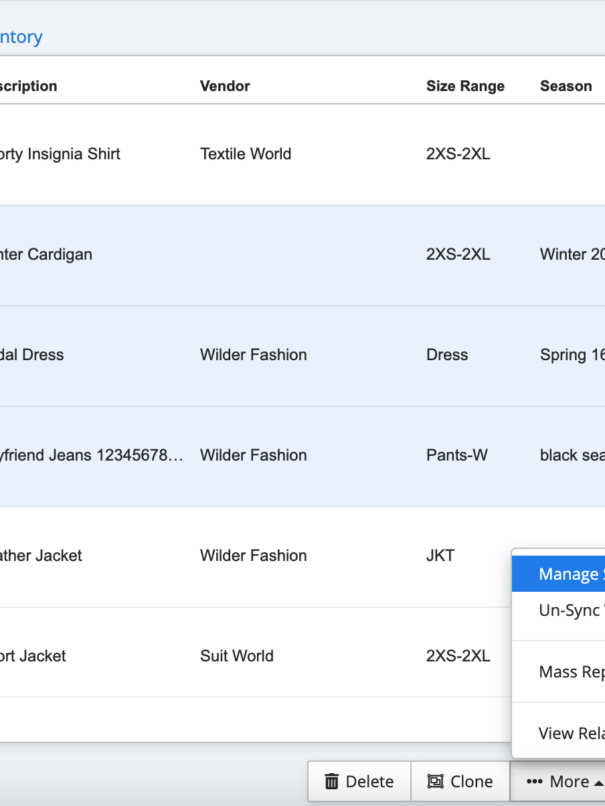Warehouses are an essential component of the supply chain. Clean and organized warehouses are prepared to accept products, fulfill orders, load containers for shipping, improve your accuracy rate, reduce storage costs, meet customer demand, and ultimately, ensure high levels of customer satisfaction.
In other words, a well-organized, streamlined apparel warehouse will keep your business operations running efficiently and have a positive effect on your bottom line.
Effective warehouse design involves a number of factors: Space optimization, designating receiving areas, identifying the best storage options for the warehouse, employing an effective warehouse management software solution, and more.
Sounds like a lot of work? Don’t worry, we’ve got you covered.
In this post, we’re offering some practical organization ideas to help you improve warehouse efficiency in no time.

Image by aleksanderlittlewolf on Freepik
Why is Apparel Warehouse Organization Important?
An organized warehouse floor plan means a number of benefits for your business, including reduced waste, reduced chances of human error, better inventory control, and reduced maintenance expenses. The main benefit, however, is the significant time and effort savings. Warehouse employee productivity increases significantly when items are arranged so they can be found more quickly. Not only does an organized storage space promote operational effectiveness but it also guarantees that you give each and every one of your customers and clients the best possible service.
An organized warehouse can also prevent safety issues because routine cleaning helps you avoid injuries and accidents brought on by slippery surfaces, falling objects, etc.
Finally, a poorly organized apparel warehouse can be a fertile environment for theft. According to the 2020 BSI & TT Club Cargo Theft Report, 14% of cargo theft in the US was from warehouses. In this situation, improved planning and security check implementation might significantly lower these figures.
How to Streamline Your Warehouse to Improve Production
Below you will find 6 tips on how to organize your apparel warehouse with the help of warehouse storage solutions, and maximize productivity.
1. Make a Floor Plan
Making a floor plan is the first step in organizing your apparel warehouse. This will allow you to determine where you want to keep your goods, but also identify any space restrictions of the building itself.
When creating your floor plan, you should arrange similar items together. This will enable you to find things much faster. For example, you might want to create an area specific for sportswear, another area for elegant gowns, etc.
You can also classify your inventory to make your putaway and picking process more effective. Consider using the ABC analysis to organize your inventory by dividing your goods into three categories according to their value. The SKUs in Group A, which is usually the smallest category, account for the vast majority (80%) of the value of your company. Mid-level SKUs will be in Group B, and SKUs with little financial impact (such as discontinued or slow-moving products) will be in Group C. By categorizing everything in this manner, you’ll be able to clearly identify the most important inventory and make sure that everything is well-organized, optimized, and accessible in your warehouse.
2. Select Shelving and Storage Solutions for Warehouse
The next step is to choose shelving and warehouse storage solutions that suit your needs. You should aim to have ample space that’s going to last. Here are some to keep in mind:
Pallet racking systems
In essence, pallet racking systems are racks made to hold and store pallets filled with inventory. A forklift or another automated method is usually used to put and retrieve inventory from storage. These systems are frequently used in industrial settings with high throughput. They can be a great way to make use of the facility’s vertical warehouse space.
Wire partitions
These are actually cages made of wire used to hold merchandise. They are a great option when time is of the essence because they can typically be installed (and removed) quite fast. Wire partitions are typically used to store large or oddly shaped objects but are not the best choice for products that are excessively fragile.
Mezzanines
A mezzanine is an additional level of storage space built within your warehouse. Adding a mezzanine to your warehouse is equivalent to adding a second or third level, increasing the amount of useful space you have available for storage and other uses. Although it can be pricey, this approach will usually be less expensive than investing in new construction and will provide you the opportunity to reclaim any wasted vertical space.
Traditional shelving
Shelving is one of the most used types of warehouse storage, and most people automatically think about it when considering warehouse storage solutions. There are two types of shelves: static and mobile. Static shelving is intended to remain in one location, usually the installation site, to create fixed isles. On the other hand, mobile shelves are usually installed on a set of wheels and carriages so that they can be moved. Mobile shelving can reduce or even eliminate the need for permanent aisles altogether.
Carton flow racks
These racks, as the name suggests, are intended to hold products at the carton level. The shelves have a small slope to them which makes the carton roll toward the front of the rack and take the space left by the one that was removed. Carton flow racks are a great choice for first-in, first-out (FIFO) operations.
Which warehouse storage solutions you choose will depend on the type of your business, the size and volume of the products that pass through your facility, and other factors. Additionally, you should think about storage bins and shipping containers. You will also need to think about storage bins and shipping containers. Once your shelving is set up and arranged in a way that ensures the safety and good circulation of products, label all shelves and sections in accordance with your floor plan.

Image by senivpetro on Freepik
3. Invest in a Warehouse Management System (WMS)
Cloud-based WMS is crucial because it provides the data necessary to support many of the warehouse organization ideas mentioned in this article.
Inventory management software with an integrated warehouse inventory system is the best option when it comes to collecting, organizing, and storing data about the amount and location of every inventory item, especially if you have multiple warehouse locations. This is very important because maintaining an organized warehouse depends on tracking your inventory levels in real time, knowing which items are in stock, where they are, and when reorders are required.
By reducing the need for manual processes, these software solutions can also help decrease your error rates. Finally, they can help you group products together or select them in the most effective order to help businesses organize their workflow.
4. Improve Your Warehouse Team
Investing in continuing education for your warehouse staff will not only contribute to a more efficient warehouse but will also help you reduce labor costs. Even though it is true that they can pick up a lot on the job, formal training tailored to their particular roles can increase morale and encourage them to aim higher.
Implementing quarterly training sessions for anyone who wants to learn more about various roles and departments might be a good idea. You can also require testing for protocols and warehouse systems once or twice a year to remind everyone of basic safety precautions and best practices.
5. Make Safety Your Priority
Safety should always be your top priority. Start with issues that are obvious, like visible floor and shelf risks. Having a solid infrastructure and well-trained workers is the first step to ensuring no one gets hurt on the job.
Consider warehouse storage solutions and systems that can improve the safety and usability of the physical space in your warehouse, such as stackable bins and shipping stations. Lastly, maintain order in the warehouse by grouping similar things together and make an effort to reduce the number of actions necessary to carry out daily duties across the warehouse in order to reduce any obstacles and ensure efficient workflow.

Image by aleksanderlittlewolf on Freepik
6. Perform Regular Reviews
Finally, you should audit your warehouse organization and inventory management procedures on a regular basis. This should include everything from the type of warehouse storage solutions you’re using to how products are arranged. To make sure you are utilizing your space to its fullest, check to see that staff members have a functional flow path, identify any obstructions and remove them, and double check your floor plan.
By prioritizing regular reviews, you’ll be able to identify which areas of your warehouse layout and warehouse operations can be improved with an aim to ultimately reduce storage costs, boost your productivity, and improve your bottom line.
The Bottom Line
The difference between an organized apparel warehouse and a chaotic one is the difference between success and failure. That being said, every warehouse has different organizational needs. Some might benefit more from inventory management software with an integrated WMS system like ApparelMagic, while others might need to employ different storage solutions for their warehouse.
We recommend that you choose one or two of the ideas listed above that and put that into action right away to improve warehouse efficiency. Organizing your apparel warehouse today will position your company for success both now and in the future.







